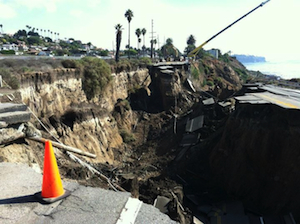Rain, irrigation and residential development contributed to November’s San Pedro Slide

It’s a long and inconclusive list of usual suspects that appear in the final draft report [PDF] released by the City of Los Angeles this week. The Department of Public Works tapped the Glendale geotechnical consulting firm Shannon and Wilson to investigate the slide that sent a 600-foot section of seaside roadway toward the Pacific last November.
My radio report and blog post back in April explained the slippery mix of water and soft sediment that permeates the Palos Verdes Peninsula, and what happens when too much water gets between those unstable layers of earth.
Shannon and Wilson’s report lists the following as “contributors” to the slide: irrigation — both residential and watering done inside the White Point Nature Preserve adjacent to the slide — coastal bluff erosion, precipitation, road construction and underground utilities. Just above the Preserve is a 13.2-acre complex of U.S. Air Force housing, and watering from those homes could be “influencing groundwater” near the slide.
Precipitation was a “significant effect,” investigators say: a smaller slide in December of 2009 “associated” with heavy rains may have destabilized the 2011 slide area. The report also mentions the two inches of rain between October, 2011, and last November when the most recent slide occurred. City of Los Angeles sewer lines, storm drains and gas and water lines built back in the 1960’s may have played a role. A city survey with video cameras late last summer and early fall found “some damage” to the storm drains. Interestingly, the only factor the investigators could rule out was the Nike Missile Base built into the hillside above the slide area.
Next come the discussions and decisions about solutions and their price tags. Check out some possible designs in a city video on L.A. City Council member Joe Buscaino’s website. He’s the Chairman of the Public Works Committee, which will be moving the repairs and reconstruction forward. The choices range from a low of several million dollars to leave the slide “as is” and build safe turnarounds for traffic on either side and several mid-range options including grading the slide or re-routing the roadway into the nature preserve for between four to eight million dollars. Two high-range options, 42 million to 62 million dollars, include restoring the roadway without a retaining wall or building a bridge across the slide.
